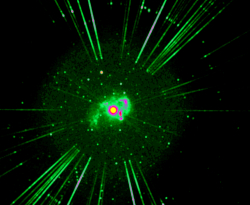 HEAPOW: Chandra XX (2019 Jul 29)
HEAPOW: Chandra XX (2019 Jul 29)
July 23, 2019 marked the 20th anniversary of the launch of the Chandra X-ray Observatory on the Space Shuttle Columbia. Chandra, as it's affectionately called, was named in honor of the Nobel-prize winning Indian astrophysicist, Subramanyan Chandrasekhar, best known for his use of quantum physics in understanding the interiors of stars, and his discovery of the maximum mass that a white dwarf can have before it collapses. The Chandra X-ray Observatory has the finest X-ray mirror and detectors yet flown on a space observatory, which allows Chandra to produce extremely detailed X-ray images and X-ray spectra. In honor of the 20th anniversary, the Chandra X-ray Center has released stunning Chandra images of the X-ray Universe from the past 20 years. The image above is the X-ray image of the well-known star system Eta Carinae. Eta Carinae is a binary system in which two very luminous and massive stars orbit each other every 5.5 years, in one of the most elliptical orbits known in astronomy. The binary produces bright, varying X-ray emission from the collision of the powerful winds of the two stars. These "colliding wind" X-rays are seen in the false-color image above as the bright yellow dot near the center of the image. One of the stars in the binary nearly destroyed itself in the middle of the 19th century, an eruption that expelled more than 20 times the mass of the Sun into space. The collision of this ejected material with surrounding gas and dust produces the broken, X-ray bright ring around the central source. The beams pointing at the system are actually X-ray "rainbows", the X-ray spectra of the star produced by Chandra's X-ray gratings in Chandra observations at many different orientations of the spacecraft. Chandra's X-ray gratings disperse the individual wavelengths of the X-ray light produced by the star, which creates the narrow streaks pointing back to Eta Carinae. This is similar to the way in which "firework glasses" produce rainbows of dispersed light from the light of exploding fireworks. Analysis of the dispersed spectra allows astronomers to determine the composition and detailed motion of the hot gas produced by the colliding winds. Chandra is such a well-designed space observatory that astronomers are eagerly anticipating further breakthrough observations for many years to come.
NASAblueshift: Chandra X-ray Observatory’s 20th Launch Anniversary
viewtopic.php?t=39649
| << Previous HEAPOW | High Energy Astrophysics Picture of the Week | Next HEAPOW >> |